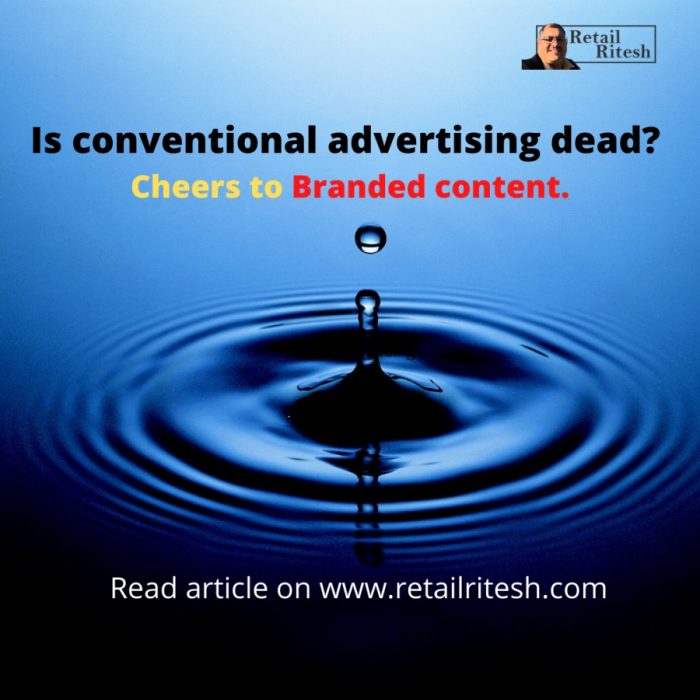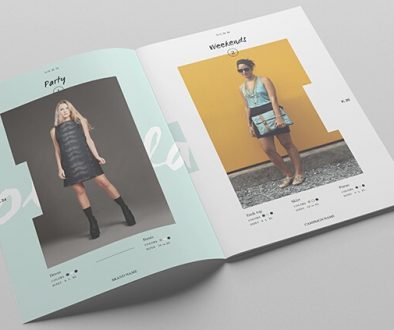Is conventional advertising dead? Cheers to Branded content.
Branded content is the new age communication tool for marketers and advertisers.
Print era vs Branded content
It was an era wherein the ideas were stronger than visibility, as there were few avenues for the brands to showcase their products or services.
“Words” were the only way to influence customers hence the era was of Print ads. In the 1980’s with the advent of televisions entering the household, visual communication using telefilms effectively, as it cut across the geographies and cultures.
Fast forward to 2020, an era of YouTube, OTT etc….Here comes advertising in its new avatar…. Branded content advertising.
Today everyone is pressed with time… One gets exposed to 100GB of ads during the day. Gone are the days wherein one simple print ad could create million-dollar sales revenues for the brands.
I still remember a classic Print ad in Indian advertising of the Prestige cooker… Here it is ….

Do you recall the famous Amul ads, In India market, Amul occupies 81% of the entire butter market, truly encapsulated by its tagline “Taste of India”.
Learn more about the most memorable ads of Indian brands, click here.
What is a Branded Content definition?
As per Wikipedia, Branded content (also known as branded entertainment) is the practice of marketing via the creation of content that is funded or outright produced by an advertiser.
In contrast to content marketing (in which content is presented first and foremost as a marketing ploy for a brand) and product placement (where advertisers pay to have references to their brands incorporated into outside creative works, such as films and television series), branded content is designed to build awareness for a brand by associating it with content that shares its values.
The content does not necessarily need to be a promotion for the brand, although it may still include product placement.
The main point to be kept in mind here is “Values”. In branded content, we talk about brand values rather than their features or functionalities.
Learn how advertising influences consumer’s behavior, click here.
Is Branded content the same as content marketing?
The answer is Yes.
Content marketing is a form of marketing focused on creating, publishing, and distributing content for a targeted audience online.[1] It is often used by businesses in order to:
- Attract attention and generate leads
- Expand their customer base
- Generate or increase online sales
- Increase brand awareness or credibility
- Engage an online community of users
In this situation, brands need to look for new ways to connect with their audience, impact them in creative ways and convey the values they represent. Branded content is a great solution to all these needs. Branded content is an effective response to an increasingly saturated market.
What has given birth to a new genre of advertising?
Branded content is a new way to appeal to customers EMOTIONALLY. And YouTube is fueling this growth.
YouTube user statistics:
- The platform has over 1.9bn logged-in monthly users.
- 6 out of 10 people prefer online video platforms to live TV.
- In an average month, 8 out of 10 18-49 year-olds watch YouTube, while 90% of America 18-24-year-olds use it
- You can navigate YouTube in a total of 80 different languages (covering 95% of the Internet population)
- Branded content has a high probability of going viral and gathers millions of views which is a limitation on conventional mediums like TVCs (Television commercials).
Watch a branded content by Ahmed foods (a brand from Pakistan)

Today, more brands prefer branded content since its storytelling format appeals to consumer’s emotions which results in generating positive brand affinity and also awareness.
Moreover, the cost feasibility of gathering a million views on YouTube makes it more viable for the brands to get ROI on their ad spends.
Learn about the business model of McDonald’s, click here.
Branded content vs typical advertising
While typical marketing campaigns are all about choosing a USP and then finding a way to convey that selling point to your customer; Branded content takes a new approach.
Rather than focusing on the product’s story, the content focuses on the consumer, their needs, and how the product can solve their problems.
This strategy allows companies to connect with their audience on a deeper level.
Branded content is more of a customer-focused type of content marketing.
It provides value to the customer, like traditional content marketing, but the focus is on making an emotional connection, not selling something.
Branded content also pulls attention to the unique values and ideals of the company, to create an affinity with readers and viewers.
Branded content example: Pillsbury’s

Few tips for the content marketers or copywriters:
- Branded content needs to generate conversation around the brand. More than looking for a direct sale or conversion, these contents try to impact the audience and spark conversation around the brand.
Therefore, the key metrics to measure the success of branded content of this type tend to focus on the number of mentions.
- Create content that your customers want to consume.
Branded content example – Watch the video by coke studio which got 32 million views.
Coke uses this property of coke studio in its key markets to promote music which can cut across geographical borders and cultures.

- Appeals to emotions. The use of emotions to convince goes back to the times of Aristotle, and today is still an effective resource. Branded content does not seek to use rational arguments about why a brand is better than the competition, but instead seeks to connect with the audience on a more intimate level.
- Use storytelling methods.
Watch below film by Google in India to honor unsung heroes;

Challenges ahead for Brands.
- To break the clutter of advertising messages on YouTube and to ensure their content strikes conversation amongst the customers.
- Lack of Idea generation amongst the creative fraternity to influence customers through emotions. Few brands have mastered the art like Fevicol, Amul, and McDonalds, etc.
To end my article, I would like to ask my advertising and marketing fraternity as to what they feel would be the future of advertising communication in the coming years.
You can express your views by commenting below.
If any of my retail fraternity members want to work out a branded content strategy for your brand or retail stores then feel free to write to me on riteshmohan@yahoo.com. I would be more than glad to support my readers with my cutting edge strategic insights and inputs.
About the author:
Ritesh Mohan is a passionate retail professional with over 20 years in the Retail sector, handling some of the biggest brands in beauty, fashion and fragrances retail & FMCG sector. He has been instrumental in the growth of some of the regional brands as well in the Middle East region. Ritesh specializes in Retail management, Product development, and Brand Management, Retail Operations, Sales Management and Franchising & Business Management. He believes in empowering business owners with his wisdom & experience of around two decades in the industry.




